Why super and growth assets like shares really are long term investments
“Aussie share market loses $100bn in bloodbath”
Two weeks ago, there were lots of headlines like that after share markets fell sharply in response to US recession fears. But such headlines are nothing new. After such falls, the usual questions are: What caused the fall? What’s the outlook? And what does it mean for superannuation? The correct answer to the latter should be something like: “Nothing really, as super is a long-term investment and share market volatility is normal”.
Super funds, shares & the power of compound interest
The next chart shows the value of a $100 investment in Australian cash, bonds, shares and residential property from 1926 assuming any interest, dividends and rents are reinvested on the way, and their annual returns. As the return series for commercial property and infrastructure only goes back a few decades I have used residential property as a proxy.
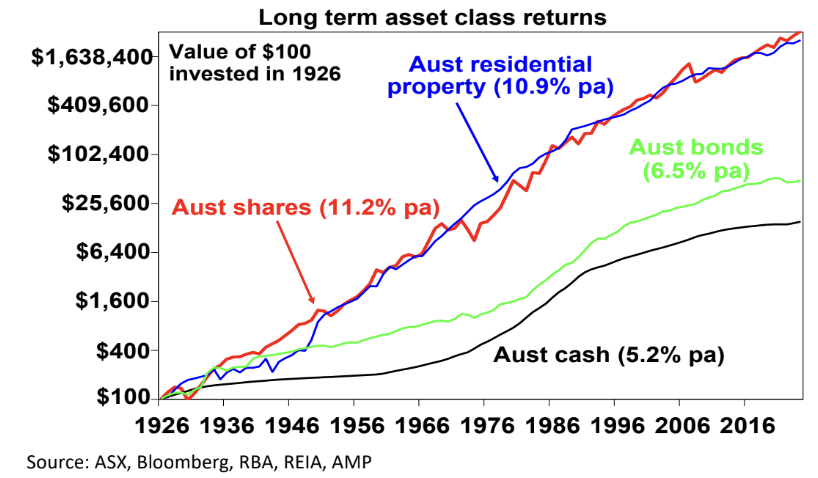
But investors don’t have 100 years?
But if you just look monthly and allow for dividends, the historical experience tells us you will only get bad news around a third of the time. And if you only look each year, you will only get negative news 20% of the time for Australian shares and 27% of the time for US shares.
And if you look just once a decade, positive returns have been seen 100% of the time for Australian shares and 82% for US shares. So, while it’s hard given the bombardment of financial news these days it makes sense to look at your returns less because then are you more likely to get positive news and less likely to make rash decisions or end up adopting an investment strategy that is too cautious.
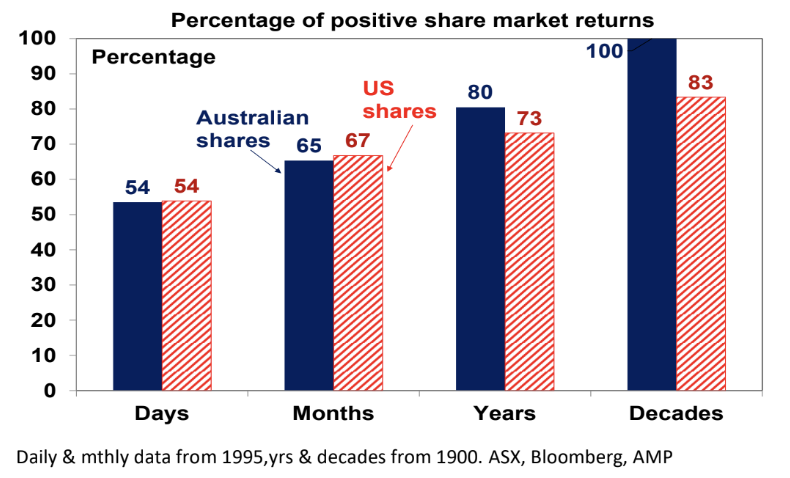
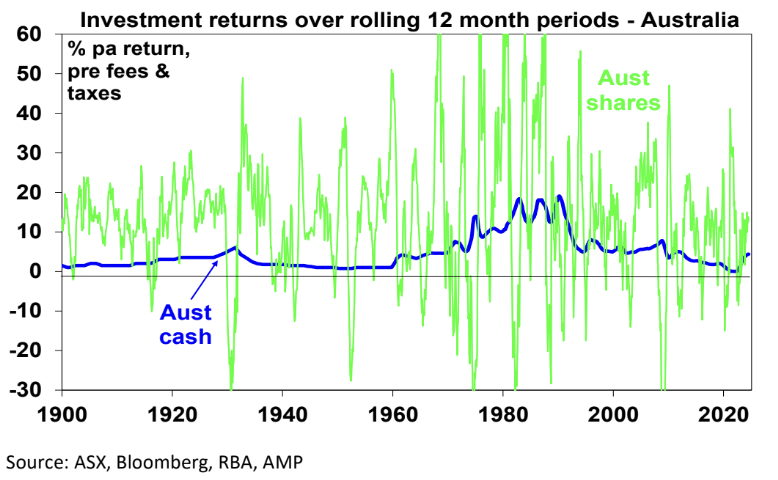
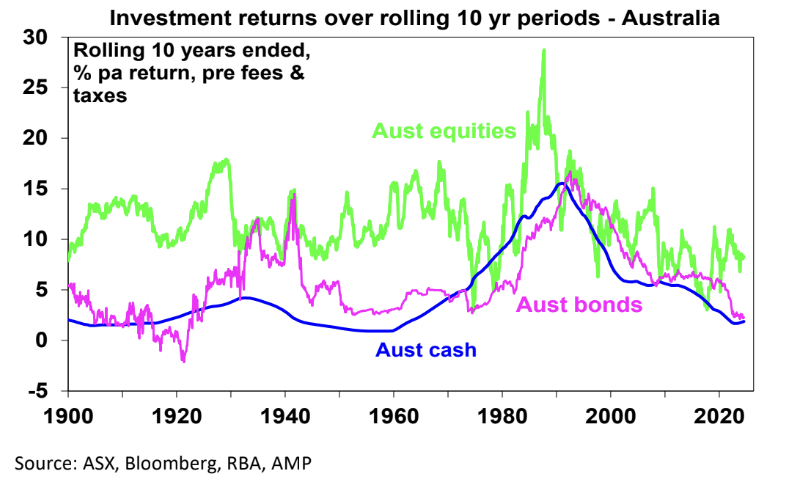
This is consistent with the basic proposition that higher short-term volatility from shares (often around periods of falling profits & a risk that companies go bust) is rewarded over the long term with higher returns.
But why not try and time short-term market moves?
The temptation to do this is immense. With the benefit of hindsight many swings in markets like the tech boom and bust, the GFC and the plunge and rebound in shares around the COVID pandemic look inevitable and hence forecastable so it’s natural to think “Why not give it a go?” by switching between cash and shares within your super to anticipate market moves. Fair enough. But without a tried and tested market timing process, trying to time the market is difficult. A good way to demonstrate this is with a comparison of returns if an investor is fully invested in shares versus missing out on the best (or worst) days.
The next chart shows that if you were fully invested in Australian shares from January 1995, you would have returned 9.5% pa (with dividends but not allowing for franking credits, tax and fees). If, by trying to time the market, you avoided the 10 worst days (yellow bars), you would have boosted your return to 12.2% pa. And if you avoided the 40 worst days, it would have been boosted to 17% pa! But this is hard, and many investors only get out after the bad returns have occurred, just in time to miss some of the best days. For example, if by trying to time the market you miss the 10 best days (blue bars), the return falls to 7.5% pa. If you miss the 40 best days, it drops to just 3.5% pa.

- A fixed balanced mix of 70% Australian equities, 25% bonds and 5% cash;
- A “switching portfolio” that starts with the above but moves 100 per cent into cash after any negative calendar year in the balanced portfolio and doesn't move back until after the balanced portfolio has a calendar year of positive returns. We have assumed a two-month lag.
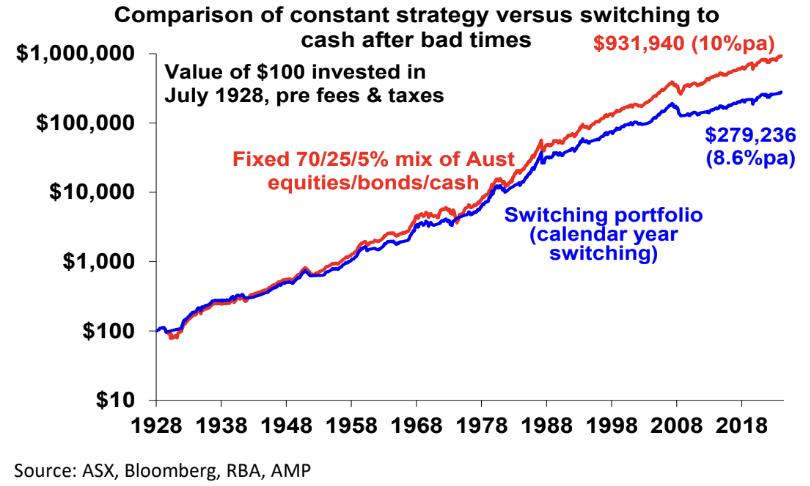
Over the long run, the switching portfolio produces an average return of 8.6% pa versus 10% pa for the balanced mix. From a $100 investment in 1928, the switching portfolio would have grown to $279,236, but the constant mix would have ended more than 3 times bigger at $931,940.
Key messages
First, while shares and growth assets have periods of short-term underperformance versus cash & bonds they provide superior long-term returns. So, it makes sense for super to have a high exposure to them.
Second, switching to cash after a bad patch is not the best strategy for maximising wealth over time. It can just lock in losses.
Third, the less you look at your investments the less you will be disappointed. This reduces the chance of selling at the wrong time. The best approach is to recognise that super and shares are long-term investments and adopt a long-term strategy to suit your circumstances – in terms of your age, income, wealth and risk tolerance.
Finally, anything that cuts your super balance early on can cut your super at retirement a lot. Eg, a $20,000 withdrawal from super at age 30 – say for a dental expense - can cut your super at age 67 by around $74,000 (in today’s dollars) due to the loss of compounding returns on that amount (using the assumptions in the ASIC MoneySmart Super calculator).

